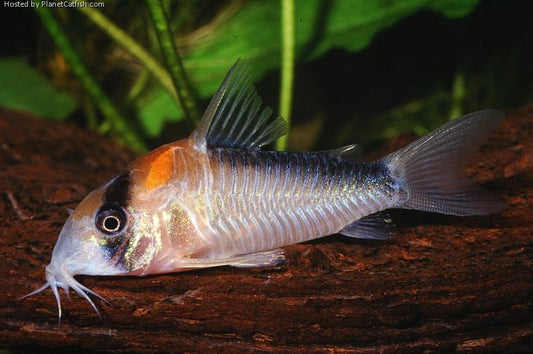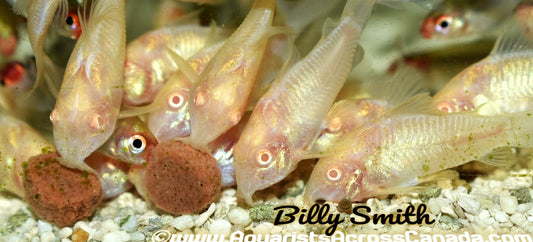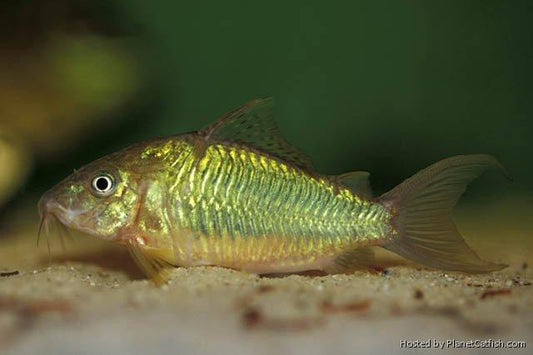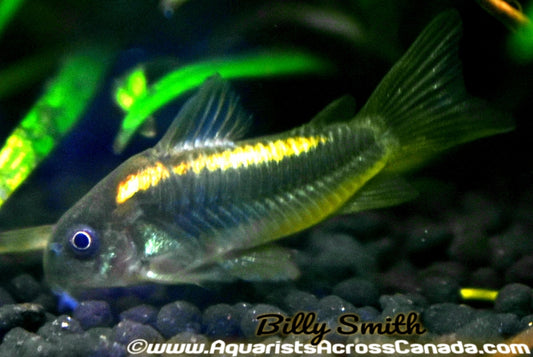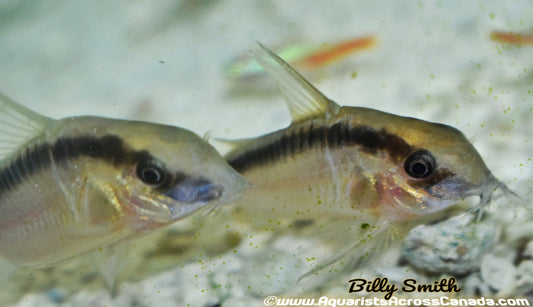Collection: Corydora
NOW WHEN YOU BUY MULTIPLES OF ANY SCHOOLING FISH A TIERED DISCOUNT IS APPLIED AUTOMATICALLY TO CART.
This applies only to fish purchased online, not in store.
One of the first bottom feeding fish many aquarists purchase is the albino Cory cat or one of its relatives. There are over 170 recognized species of Corydoras, with 100+ species yet to be given scientific names. They belong to the Family Callichthyidae and range throughout South America, from the Andes Mountains to the Atlantic coast, and from Trinidad to northern Argentina. Brochis and Aspidoras catfish occupy smaller overlapping ranges, and are included in this care sheet as they have similar aquarium needs. All three genera are peaceful bottom feeders that can be kept in community aquariums. They are heavily armored and have sharp spines on their pectoral and dorsal fins. Care should be taken when handling them, as some species have a mild toxin in their spines.
Corydoras, Brochis and Aspidoras catfish are shoaling fish, meaning they like to hang out together. Different species can be mixed and they will often group together. For best results, they should be purchased in groups of 5 or more. These catfish will sometimes dart to the surface to gulp air. This behavior is normal, however, gasping at the surface constantly may be an indication of water quality problems or low oxygen content. Unlike many catfish, which are nocturnal and can be secretive, Corys and their relatives tend to be out and about during the daytime. They can be kept with most peaceful community fish. Because different species attain various sizes as adults, species selection should be based on tank size and the types of fish you keep. Always consult an aquarium expert before buying any new fish for your aquarium.
Corydoras catfish and their relatives are omnivores and typically feed on the bottom, although it is not uncommon for them to learn to come to the surface for food when hungry. For best results feed a variety of high quality foods, and rotate your fishes’ diet daily. Feed only what your fish can consume in 2 to 3 minutes, once or twice a day.
-
ADOLFOI CORYDORA (Corydoras adolfoi) 2403
Regular price From $27.99 CADRegular priceUnit price / per -
ALBINO CORYDORA (Corydoras aeneus .var) 2404
Regular price $6.74 CADRegular priceUnit price / per$8.99 CADSale price $6.74 CADSale -
ALBINO PYGMY CORYDORA (Corydoras pygmaeus)
Regular price $14.99 CADRegular priceUnit price / per -
 Sold out
Sold outBANDIT CORYDORA (Corydoras metae)
Regular price $14.99 CADRegular priceUnit price / per -
BLACK VENEZUELAN CORYDORA (Corydoras .Sp Black Venezuelan)
Regular price $39.99 CADRegular priceUnit price / per -
BLUSHING ADOLFOI CORYDORA (Corydoras C121)
Regular price $27.99 CADRegular priceUnit price / per -
C005 ALBERTINI CORYDORAS *RARE* (Corydoras Albertini)
Regular price $59.99 CADRegular priceUnit price / per -
CORYDORAS ZYGATUS (Osteogaster Zygatus)
Regular price $14.99 CADRegular priceUnit price / per -
DUPLICAREUS CORYDORA (Corydoras Duplicareus)
Regular price $29.99 CADRegular priceUnit price / per -
ELEGANT CORYDORAS (Gastrodermus Elegans)
Regular price $9.99 CADRegular priceUnit price / per -
 Sold out
Sold outELLIS CORYDORA (Corydoras ellisae)
Regular price $9.99 CADRegular priceUnit price / per -
EMERALD GREEN CORYDORAS (Brochis splendens)
Regular price $19.99 CADRegular priceUnit price / per -
FALSE JULII CORYDORA (Corydoras trilineatus) 2402
Regular price $9.74 CADRegular priceUnit price / per$12.99 CADSale price $9.74 CADSale -
GOLD LASER CORYDORA (Corydoras sp. (Cw010 Rio Ucayali) TA2407
Regular price From $29.99 CADRegular priceUnit price / per -
GREEN/BRONZE CORYDORA (Corydoras aeneus) 2404
Regular price $5.99 CADRegular priceUnit price / per$7.99 CADSale price $5.99 CADSale -
LOXOZONUS CORYDORA (Hoplosoma Loxozonus)
Regular price $14.99 CADRegular priceUnit price / per -
PANDA CORYDORA Corydoras panda) 2402
Regular price $7.99 CADRegular priceUnit price / per$9.99 CADSale price $7.99 CADSale -
PEPPERED CORYDORA (Corydoras paleatus)
Regular price $5.99 CADRegular priceUnit price / per$7.99 CADSale price $5.99 CADSale -
PYGMY CORYDORA (Corydoras pygmaeus)
Regular price $7.49 CADRegular priceUnit price / per$9.99 CADSale price $7.49 CADSale -
 Sold out
Sold outSIMILIS CORYDORA (Corydoras Similis)
Regular price $14.99 CADRegular priceUnit price / per -
SKUNK CORYDORA (Corydoras Arcuatus C020)
Regular price $14.99 CADRegular priceUnit price / per -
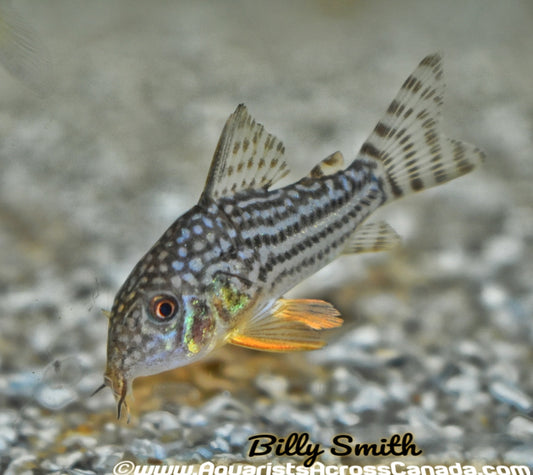 Sold out
Sold outSTERBAI CORYDORA (Corydoras sterbai)
Regular price $11.99 CADRegular priceUnit price / per$14.99 CADSale price $11.99 CADSold out -
VENEZUELAN CORYDORA (Corydoras Venezuelanus) 1-1.5" (2.5-4cm) 2404
Regular price $24.99 CADRegular priceUnit price / per

